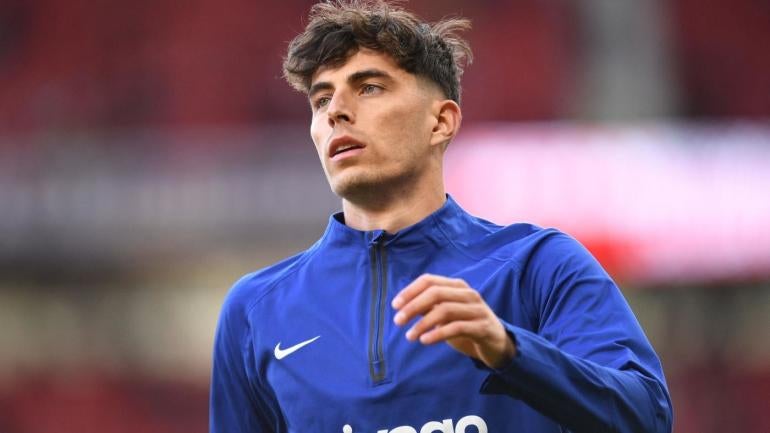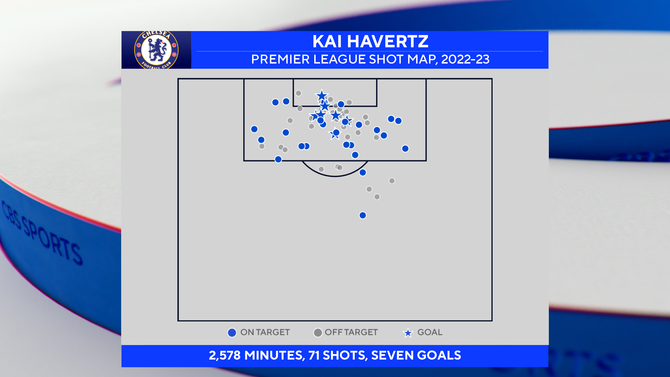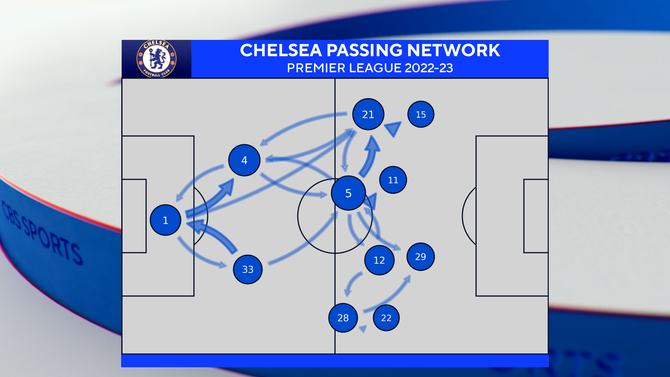
Three years after Europe's most coveted young player made a blockbuster move to one of the most dramatic clubs in world football's biggest league, Kai Havertz still retains that rarest of qualities at the elite level of football: the lure of the unknown. At 24 years of age his story is less of what he has done and will do than what he might be.
Arsenal are about to find out exactly what that potential coalesces into. The team officially announced their new signing today, revealing their new attacker on social media.
We keep moving forward.
— Arsenal (@Arsenal) June 28, 2023
Kai Havertz is a Gunner ❤️ pic.twitter.com/76j5BStw9e
Chelsea were not exactly eager to part ways with Havertz, but with two years left on his contract and no indication coming from him that he would be willing to sign an extension, he became a prime candidate to be sold as the Blues look to balance their books before June 30.
Real Madrid and Bayern Munich were credited with an interest but ultimately never looked like matching the sort of price the Gunners committed to. It did not take much to convince Havertz on Arsenal too, one of his formative footballing memories is the Champions League final that so far is Arsenal's sole appearance in the showpiece match, their 2006 loss to Barcelona in Paris. If he can help to take them one step further in the coming years then the sizeable price the Gunners are committing to, one that so far is only bettered by the £72 million they misspent on Nicolas Pepe, will prove to be a bargain (though Declan Rice is soon to top them both).
More profoundly at the Emirates Stadium, he will benefit from the sort of organizational stability that simply never existed in his three years at Stamford Bridge. In his time at Chelsea, he went through four managerial changes and there is a certain irony that his first and last games in blue came with Frank Lampard in the dugout, despite the fact that they won a Champions League and Club World Cup -- with Havertz scoring the winning goal in both finals -- in the intervening years, Chelsea somehow ended up back where they were when Roman Abramovich sanctioned a Bundesliga spending spree in the midst of the COVID-19 pandemic, a long way off Manchester City.
Do Havertz's struggles reflect Chelsea's?
That he arrived in such testing circumstances is worth noting. Havertz described those first six months after his move from Bayer Leverkusen as the most challenging of his career. He felt unable to fully escape the £80 million price tag that had been paid for him, telling CBS Sports in May 2021.
"At the beginning, it felt like I had a big backpack on my shoulders [when I was playing]," he said.
His first season may have ended with a Champions League winner but he was rocked by a particularly tough bout of COVID-19 and an injury in February. All this might be easier to deal with in the region of North-Rhine Westphalia where he had spent the first 21 years of his life, instead, he had upped stick to a London that was no buzzing metropolis but was instead in the grip of lockdowns.
Year two brought ownership turmoil and a new striker that Havertz had to adapt to playing alongside, and like so many in Chelsea shirts, he struggled to get on a wavelength with Romelu Lukaku. His final season was riven by yet more chaos, three different managers and what must have seemed like a new teammate every week. That backpack never came off his shoulders, instead it was loaded up with ever more detritus.
The turbulence around Havertz goes some way to explaining why the raw numbers he produced at Chelsea hardly scream £65 million. In 137 appearances, he scored 31 goals and provided 13 assists, averaging a goal contribution every 200 minutes. That's hardly a disastrous number but it does not set the world alight either. One might point to the mitigating factor that Havertz gets himself and his teammates into scoring positions altogether more frequently than the ball ends up in the back of the net. In the last three Premier League seasons his seven assists have come from passes by Havertz worth a combined 8.1 expected assists (xA).
The underperformance is all the more profound when it comes to Havertz's shooting. Over the last three seasons, he has scored 19 Premier League goals from 24.4 expected goals (xG). That underperformance of more than five fewer goals than the average striker would score the 11th-worst mark in the English top flight, a comparable mark to such misfiring strikers as Dominic Solanke, Wout Weghorst and (gulp) Timo Werner. Last season's shot map in particular shows a sizeable number of high-value chances in prime penalty box locations go missing.

Havertz can have the feel of a cursed man in front of goal, the sort who can spurn a one-on-one with Alisson only to see the ball bounce back off the Liverpool goalkeeper, into him and then into the net. Then as he wheels off in celebration VAR has a word in the ear of the referee and it transpires that his stroke of good fortune is nullified because the ball hit his arm. If the footballing gods do exist, Havertz is a fly to those wanton boys.
Of course, xG underperformance is hardly a crisis. The 13th-worst mark in the list set out above belongs to Gabriel Jesus, the player who transformed Arsenal on his arrival from Manchester City a year ago. In both his case and Havertz's there is nothing about the way they strike the ball, the spaces they find in the penalty area and their physical profile that would suggest to you that they will not eventually progress toward the mean ... unless Arteta is inadvertently collecting a team of hexed men.
Even if the scoring does not catch the eye there is plenty else to admire in Havertz's statistics. According to fbref, he ranks in the 90th percentile or higher among forwards in Europe's top five leagues for tackles, blocks and clearances. His ball recoveries (2.83 per 90) just about shade his turnovers (2.76 per 90) and he won 2.76 aerial duels per 90, the eighth-best mark in the top flight. Considering that the missing ingredient in Arsenal's frontline looks to be height, that is a big plus.
There are other metrics that give one pause for thought, particularly Statsbomb data from February which had Havertz as by some distance Chelsea's worst player in terms of on ball value, a metric that assesses how every player's ball touch helps or hinders their team's pursuit of a goal. Even that has something of an easy explanation, however. Chelsea's attack was so toothless, devoid of guile and automatisms that Havertz was often left to fend for himself, competing in far more aerial duels in his third season than the two before him. It's hardly a surprise that Havertz could do so little with the ball when there was so little around him. Bad team, bad stats.

That is a reminder of why mapping Chelsea's Havertz, particularly from last season, onto Arsenal can be so challenging. For 80 percent of last season, the Gunners were everything that their London rivals were not on the pitch: creative, organized, ingenious and, above all, winners. In the Emirates Stadium's corridors of power, there is order and meticulous planning; both clubs might have incorrectly assessed the qualities of Mykhailo Mudryk but it was Arsenal who knew when to back away. There is, then, an environment that is altogether more conducive to players making a success of themselves.
Where does he fit at Arsenal?
The biggest question where Havertz is concerned is whether there is a spot for him on the pitch. Going into the summer Arsenal wanted to strengthen in four positions: a versatile defender, two midfielders (one of whom would replace the outgoing Granit Xhaka) and a versatile forward who could fit in across the frontline. It is easy to see how Havertz can do the latter.
"I'm not a real No. 9 but something in between, that suits me very well and I feel very confident there," he told us two years ago.
Havertz's best form came as a second striker at Bayer Leverkusen but he impressed as the false nine when Tuchel took charge in his first season. He may not be the natural cover for Bukayo Saka that Arsenal needed late last season but Arteta might already have that in Gabriel Jesus, who was one of the league's best right wingers before he left Manchester City. With the left side already well stocked, Havertz's addition means Arsenal have depth across the frontline and a quartet of center forward options including Leandro Trossard and Eddie Nketiah who could all interpret the role rather differently.
Havertz's role as an alternate in the front three is not what is most intriguing the boisterous Arsenal fanbase, however. After all, the Gunners are paying a starter fee and starter wages to the Germany international. If there is going to be a place in the XI for him to fill it is Xhaka's, the former club captain bound for Bayer Leverkusen once Arteta has secured reinforcements in midfield. In possession, the addition is tempting.
In 2022-23, Arteta challenged Xhaka to change his game radically, becoming a left eight who attacked the box, creating overloads and often functioning as Arsenal's default center forward when Jesus drifted wide to combine with Gabriel Martinelli. The Swiss international picked up his new role with greater aplomb than anyone might reasonably have expected, a player that averaged 0.8 touches in the opposition penalty area per 90 minutes in the three proceeding seasons seeing that number rocket up to 3.33. Unsurprisingly the goals came too, the seven he scored in the 2022-23 Premier League as many as he had registered in the four years before. He was, however, still a deeper-lying midfielder doing a shift rather than a natural in the role. Havertz is an altogether more natural raumdeuter.
Without the ball is where the questions lie. When Arsenal conceded possession last season they worked to win it back in a 4-4-2 structure, right-eight Martin Odegaard pushing up alongside the center forward to marshal the press. He is one of the best players in the Premier League at organizing that frontline of ball recoveries and Arteta's side were exceptional at channeling their opponents into the sort of hurried punts that William Saliba and Gabriel could easily sweep up. Xhaka, meanwhile, impressed in the sort of off-ball work that never shows up in statistical models, plugging gaps that were left by the drifts into midfield of Oleksandr Zinchenko, for instance.
How does swapping out Havertz for Xhaka change things? The German's pressing from the front is rather solid, for instance, he averaged a ball recovery in what Wyscout terms a dangerous area once every three full games and put up good numbers in terms of regaining possession in the final third and counter-pressing. Would dropping Odegaard further back when Arsenal are out of possession leave them rather easier to craft open? Would this merely be an approach to be adopted in the games Arteta expects to dominate and when the Manchester Citys and Real Madrids come into town would Havertz make way for the defensive nous of Jorginho or another new signing? Surely Emile Smith Rowe and Fabio Vieira would offer enough attacking thrust as a left eight to overcome those more favorable opponents? Arsenal don't have infinite funds like their presumptive Premier League rival for next season can access, is it shrewd to spend so much on a hunch? How can anyone possibly say with certainty what the £65 million fit will be when they have never seen him play a game in this system?
That is rather the issue with Havertz. Three years at Chelsea have not particularly answered the questions that were posed over him when he left Germany for England, instead they have generated more. At 24 years of age, there is still time to remold this premium lump of clay but it is drying quickly, it is not as easy to see the shape of the potential Ballon d'Or winner he was once labeled. There is a great deal of finding out to do. As Havertz arrives at the club number three, he remains tantalizingly unknowable.






















